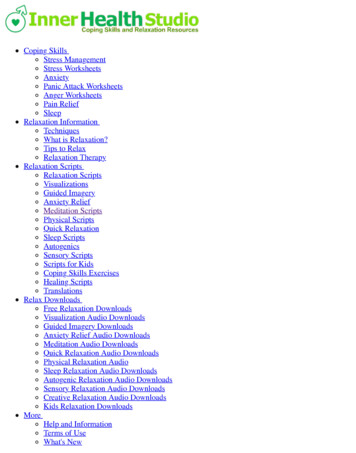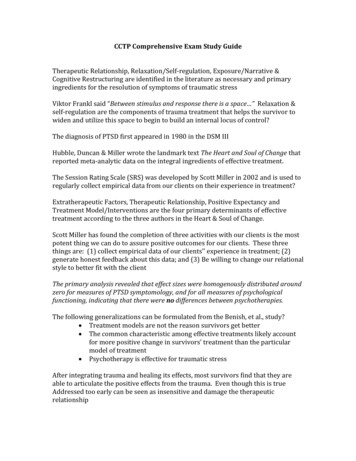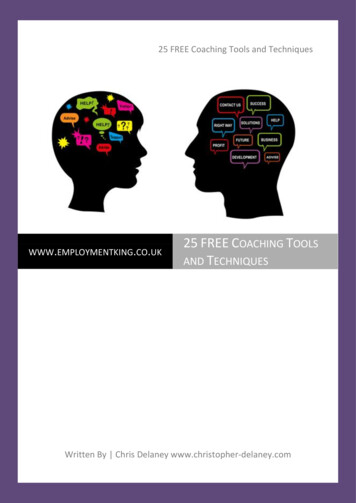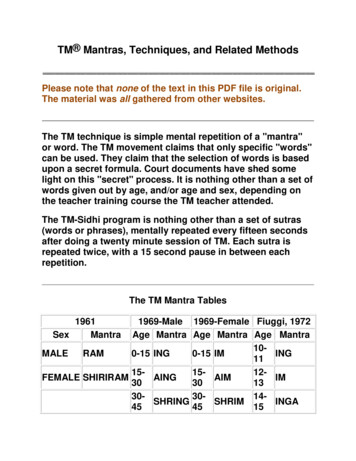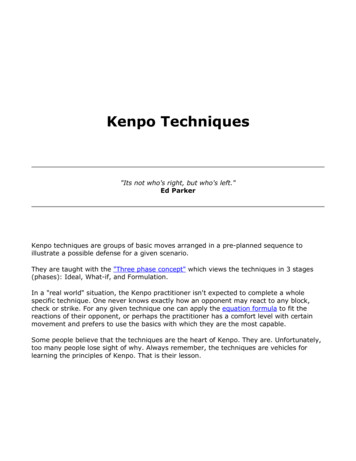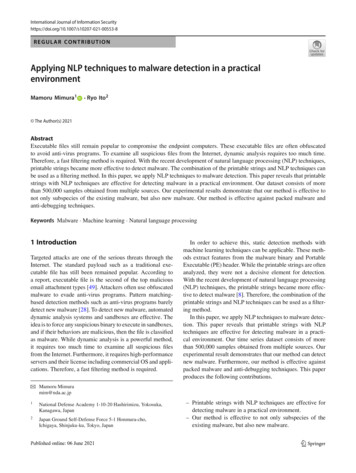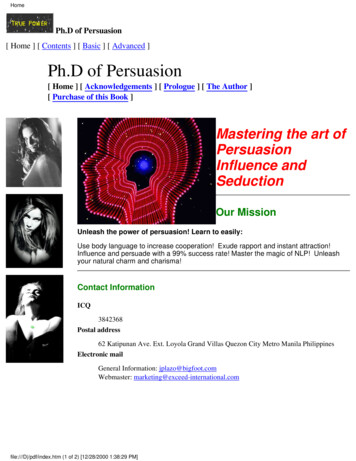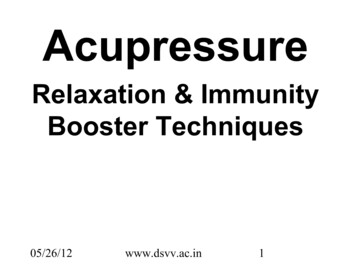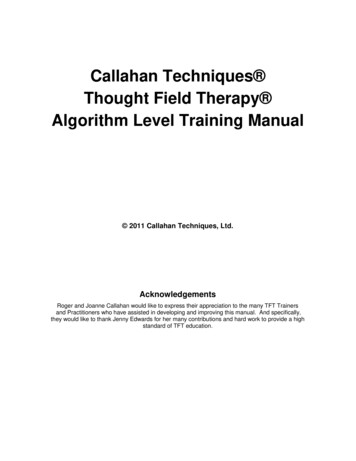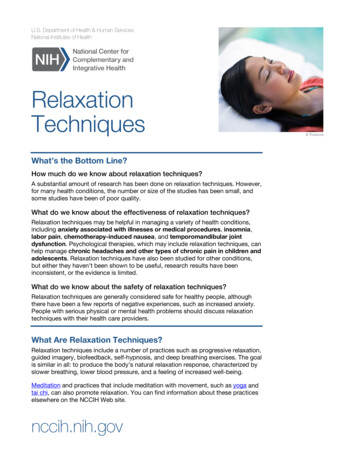
Transcription
U.S. Department of Health & Human ServicesNational Institutes of HealthRelaxationTechniquesWhat’s the Bottom Line?How much do we know about relaxation techniques?A substantial amount of research has been done on relaxation techniques. However,for many health conditions, the number or size of the studies has been small, andsome studies have been of poor quality.What do we know about the effectiveness of relaxation techniques?Relaxation techniques may be helpful in managing a variety of health conditions,including anxiety associated with illnesses or medical procedures, insomnia,labor pain, chemotherapy-induced nausea, and temporomandibular jointdysfunction. Psychological therapies, which may include relaxation techniques, canhelp manage chronic headaches and other types of chronic pain in children andadolescents. Relaxation techniques have also been studied for other conditions,but either they haven’t been shown to be useful, research results have beeninconsistent, or the evidence is limited.What do we know about the safety of relaxation techniques?Relaxation techniques are generally considered safe for healthy people, althoughthere have been a few reports of negative experiences, such as increased anxiety.People with serious physical or mental health problems should discuss relaxationtechniques with their health care providers.What Are Relaxation Techniques?Relaxation techniques include a number of practices such as progressive relaxation,guided imagery, biofeedback, self-hypnosis, and deep breathing exercises. The goalis similar in all: to produce the body’s natural relaxation response, characterized byslower breathing, lower blood pressure, and a feeling of increased well-being.Meditation and practices that include meditation with movement, such as yoga andtai chi, can also promote relaxation. You can find information about these practiceselsewhere on the NCCIH Web site.nccih.nih.gov Thinkstock
National Center for Complementary and Integrative HealthRelaxation TechniquesStress management programs commonly include relaxation techniques. Relaxationtechniques have also been studied to see whether they might be of value inmanaging various health problems.The Importance of PracticeRelaxation techniques are skills, and like other skills, they need practice. Peoplewho use relaxation techniques frequently are more likely to benefit from them.Regular, frequent practice is particularly important if you’re using relaxationtechniques to help manage a chronic health problem. Continuing use of relaxationtechniques is more effective than short-term use.Relaxation techniques include the following:— Autogenic Training. In autogenic training, you learn to concentrate on the physicalsensations of warmth, heaviness, and relaxation in different parts of your body.— Biofeedback-Assisted Relaxation. Biofeedback techniques measure bodyfunctions and give you information about them so that you can learn to controlthem. Biofeedback-assisted relaxation uses electronic devices to teach you toproduce changes in your body that are associated with relaxation, such asreduced muscle tension.— Deep Breathing or Breathing Exercises. This technique involves focusing ontaking slow, deep, even breaths.— Guided Imagery. For this technique, people are taught to focus on pleasantimages to replace negative or stressful feelings. Guided imagery may be selfdirected or led by a practitioner or a recording.— Progressive Relaxation. This technique, also called Jacobson relaxation orprogressive muscle relaxation, involves tightening and relaxing various musclegroups. Progressive relaxation is often combined with guided imagery andbreathing exercises.— Self-Hypnosis. In self-hypnosis programs, people are taught to producethe relaxation response when prompted by a phrase or nonverbal cue (calleda “suggestion”).What the Science Says About the Effectiveness ofRelaxation TechniquesResearchers have evaluated relaxation techniques to see whether they could play arole in managing a variety of health conditions, including the following:AnxietyStudies have shown relaxation techniques may reduce anxiety in people with ongoinghealth problems such as heart disease or inflammatory bowel disease, and in thosewho are having medical procedures such as breast biopsies or dental treatment.Relaxation techniques have also been shown to be useful for older adults with anxiety.On the other hand, relaxation techniques may not be the best way to help peoplewith generalized anxiety disorder. Generalized anxiety disorder is a mental healthcondition, lasting for months or longer, in which a person is often worried or anxiousabout many things and finds it hard to control the anxiety. Studies indicate thatlong-term results are better in people with generalized anxiety disorder who receive2
National Center for Complementary and Integrative HealthRelaxation Techniquesa type of psychotherapy called cognitive-behavioral therapy than in those who aretaught relaxation techniques.AsthmaThere hasn’t been enough research to show whether relaxation techniques canrelieve asthma symptoms in either adults or children.ChildbirthRelaxation techniques such as guided imagery, progressive muscle relaxation, andbreathing techniques may be useful in managing labor pain. Studies have shownthat women who were taught self-hypnosis have a decreased need for painmedicine during labor. Biofeedback hasn’t been shown to relieve labor pain.DepressionAn evaluation of 15 studies concluded that relaxation techniques are better than notreatment in reducing symptoms of depression but are not as beneficial aspsychological therapies such as cognitive-behavioral therapy.EpilepsyThere’s no reliable evidence that relaxation techniques are useful in managing epilepsy.Fibromyalgia— Studies of guided imagery for fibromyalgia have had inconsistent results.— A 2013 evaluation of the research concluded that electromyographic (EMG)biofeedback, in which people are taught to control and reduce muscle tension,helped to reduce fibromyalgia pain, at least for short periods of time. However,EMG biofeedback didn’t affect sleep problems, depression, fatigue, or healthrelated quality of life in people with fibromyalgia, and its long-term effects haven’tbeen established.Headache— Biofeedback. Biofeedback has been studied for both tension headachesand migraines. An evaluation of high-quality studies concluded that there’s conflictingevidence about whether biofeedback can relieve tension headaches. Studies have shown decreases in the frequency of migraines in people whowere using biofeedback. However, it’s unclear whether biofeedback is betterthan a placebo.— Other Relaxation Techniques. Relaxation techniques other than biofeedbackhave been studied for tension headaches. An evaluation of high-quality studiesfound conflicting evidence on whether relaxation techniques are better than notreatment or a placebo. Some studies suggest that other relaxation techniquesare less effective than biofeedback.Heart DiseaseIn people with heart disease, studies have shown relaxation techniques can reducestress and anxiety and may also have beneficial effects on physical measures suchas heart rate.3
National Center for Complementary and Integrative HealthRelaxation TechniquesHigh Blood PressureStress can lead to a short-term increase in blood pressure, and the relaxationresponse has been shown to reduce blood pressure on a short-term basis, allowingpeople to reduce their need for blood pressure medication. However, it’s uncertainwhether relaxation techniques can have long-term effects on high blood pressure.InsomniaThere’s evidence that relaxation techniques can be helpful in managing chronicinsomnia. Relaxation techniques can be combined with other strategies for getting agood night’s sleep, such as maintaining a consistent sleep schedule; avoidingcaffeine, alcohol, heavy meals, and strenuous exercise too close to bedtime; andsleeping in a quiet, cool, dark room.Irritable Bowel SyndromeAn evaluation of research results by the American College of Gastroenterologyconcluded that relaxation techniques haven’t been shown to help irritable bowelsyndrome. However, other psychological therapies, including cognitive-behavioraltherapy and hypnotherapy, are associated with overall symptom improvement inpeople with irritable bowel syndrome.Menopause SymptomsRelaxation techniques have been studied for hot flashes and other symptomsassociated with menopause, but the quality of the research isn’t high enough toallow definite conclusions to be reached.Menstrual CrampsSome research suggests that relaxation techniques may be beneficial for menstrualcramps, but definite conclusions can’t be reached because of the small number ofparticipants in the studies and the poor quality of some of the research.NauseaAn evaluation of the research evidence concluded that some relaxation techniques,including guided imagery and progressive muscle relaxation, are likely to beeffective in relieving nausea caused by cancer chemotherapy when used incombination with anti-nausea drugs.NightmaresSome studies have indicated that relaxation exercises may be an effective approachfor nightmares of unknown cause and those associated with posttraumatic stressdisorder. However, an assessment of many studies concluded that relaxation is lesshelpful than more extensive forms of treatment (psychotherapy or medication).PainEvaluations of the research evidence have found promising but not conclusiveevidence that guided imagery may help relieve some musculoskeletal pain (paininvolving the bones or muscles) and other types of pain.An analysis of data on hospitalized cancer patients showed that those who receivedintegrative medicine therapies, such as guided imagery and relaxation responsetraining, during their hospitalization had reductions in both pain and anxiety.4
National Center for Complementary and Integrative HealthRelaxation TechniquesPain in Children and AdolescentsA 2014 evaluation of the scientific evidence found that psychological therapies,which may include relaxation techniques as well as other approaches such ascognitive-behavioral therapy, can reduce pain in children and adolescents withchronic headaches or other types of chronic pain. The evidence is particularlypromising for headaches: the effect on pain may last for several months aftertreatment, and the therapies also help to reduce anxiety.Posttraumatic Stress DisorderStudies of biofeedback and other relaxation techniques for posttraumatic stressdisorder have had inconsistent results.Rheumatoid ArthritisThere’s limited evidence that biofeedback or other relaxation techniques might bevaluable additions to treatment programs for rheumatoid arthritis.Ringing in the Ears (Tinnitus)Only a few studies have evaluated relaxation techniques for ringing in the ears. Thelimited evidence from these studies suggests that relaxation techniques might beuseful, especially in reducing the intrusiveness of the problem.Smoking Cessation— Limited evidence suggests that guided imagery may be a valuable tool for peoplewho are working to quit smoking.— In a study that compared the two techniques, autogenic training was found to beless effective than cognitive-behavioral therapy as a quit-smoking aid. However,this study involved patients in an alcohol detoxification program, so its resultsmay not be applicable to other people.— Preliminary research suggests that a guided relaxation routine might help reducecigarette cravings.Temporomandibular Joint DysfunctionProblems with the temporomandibular joint (the joint that connects the jaw to theside of the head) can cause pain and difficulty moving the jaw. A few studies haveshown that programs that include relaxation techniques may help relieve symptomsof temporomandibular joint dysfunction.What the Science Says About the Safety and Side Effectsof Relaxation Techniques— Relaxation techniques are generally considered safe for healthy people. However,occasionally, people report negative experiences such as increased anxiety,intrusive thoughts, or fear of losing control.— There have been rare reports that certain relaxation techniques might cause orworsen symptoms in people with epilepsy or certain psychiatric conditions, orwith a history of abuse or trauma. People with heart disease should talk to theirhealth care provider before doing progressive muscle relaxation.5
National Center for Complementary and Integrative HealthRelaxation TechniquesNCCIH-Funded ResearchNCCIH is supporting a variety of studies on relaxation techniques. Examples oftopics currently being studied include— The use of relaxation techniques and other complementary approaches for backpain in real-world health care settings.— Guided imagery and relaxation response training for pain management inhospitalized patients.Who Teaches Relaxation Techniques?A variety of professionals, including physicians, psychologists, social workers,nurses, and complementary health practitioners, may teach relaxation techniques.Also, people sometimes learn the simpler relaxation techniques on their own.More to Consider— If you have severe or long-lasting symptoms of any kind, see your health careprovider. You might have a condition that needs to be treated promptly. Forexample, if depression or anxiety persists, it’s important to seek help from aqualified health care professional.— Tell all your health care providers about any complementary or integrative healthapproaches you use. Give them a full picture of what you do to manage yourhealth. This will help ensure coordinated and safe care.For More InformationNCCIH ClearinghouseThe NCCIH Clearinghouse provides information on NCCIH and complementary andintegrative health approaches, including publications and searches of Federaldatabases of scientific and medical literature. The Clearinghouse does not providemedical advice, treatment recommendations, or referrals to practitioners.Toll-free in the U.S.: 1-888-644-6226TTY (for deaf and hard-of-hearing callers): 1-866-464-3615Web site: nccih.nih.govE-mail: info@nccih.nih.govPubMed A service of the National Library of Medicine (NLM), PubMed contains publicationinformation and (in most cases) brief summaries of articles from scientific andmedical journals. For guidance from NCCIH on using PubMed, see How To FindInformation About Complementary Health Approaches on PubMed.Web site: www.ncbi.nlm.nih.gov/pubmed6
National Center for Complementary and Integrative HealthRelaxation TechniquesResearch Portfolio Online Reporting Tools Expenditures & Results(RePORTER)RePORTER is a database of information on federally funded scientific and medicalresearch projects being conducted at research institutions.Web site: projectreporter.nih.gov/reporter.cfmNIH Clinical Research Trials and YouThe National Institutes of Health (NIH) has created a Web site, NIH Clinical ResearchTrials and You, to help people learn about clinical trials, why they matter, and howto participate. The site includes questions and answers about clinical trials,guidance on how to find clinical trials through ClinicalTrials.gov and other resources,and stories about the personal experiences of clinical trial participants. Clinical trialsare necessary to find better ways to prevent, diagnose, and treat diseases.Web site: www.nih.gov/health/clinicaltrials/Cochrane Database of Systematic ReviewsThe Cochrane Database of Systematic Reviews is a collection of evidence-basedreviews produced by the Cochrane Library, an international nonprofit organization.The reviews summarize the results of clinical trials on health care interventions.Summaries are free; full-text reviews are by subscription only.Web site: www.cochranelibrary.comKey ReferencesBrandt LJ, Chey WD, Foxx-Orenstein AE, et al. An evidence-based systematic review on the managementof irritable bowel syndrome: American College of Gastroenterology Task Force on IBS. American Journalof Gastroenterology. 2009;104(Suppl 1):S1–S35.Cuijpers P, Sijbrandij M, Koole S, et al. Psychological treatment of generalized anxiety disorder: a meta-analysis.Clinical Psychology Review. 2014;34(2):130–140.Dickinson HO, Beyer FR, Ford GA, et al. Relaxation therapies for the management of primary hypertension inadults. Cochrane Database of Systematic Reviews. 2008;(1):CD004935 [edited 2009]. Accessed atwww.cochranelibrary.com on April 1, 2014.Dissanayake RK, Bertouch JV. Psychosocial interventions as adjunct therapy for patients with rheumatoidarthritis: a systematic review. International Journal of Rheumatic Diseases. 2010;13(4):324–334.Dusek JA, Benson H. Mind-body medicine: a model of the comparative clinical impact of the acute stressand relaxation responses. Minnesota Medicine. 2009;92(5):47–50.Dusek JA, Hibberd PL, Buczynski B, et al. Stress management versus lifestyle modification on systolichypertension and medication elimination: a randomized trial. Journal of Alternative and ComplementaryMedicine. 2008;14(2):129–138.Eccleston C, Palermo TM, Williams AC, et al. Psychological therapies for the management of chronic andrecurrent pain in children and adolescents. Cochrane Database of Systematic Reviews.2014;(5):CD003968. Accessed at www.cochranelibrary.com on December 4, 2014.Glombiewski JA, Bernardy K, Häuser W. Efficacy of EMG- and EEG-biofeedback in fibromyalgia syndrome:a meta-analysis and a systematic review of randomized controlled trials. Evidence-Based Complementaryand Alternative Medicine. 2013;2013:962741.Hoare DJ, Kowalkowski VL, Kang S, et al. Systematic review and meta-analyses of randomized controlledtrials examining tinnitus management. Laryngoscope. 2011;121(7):1555–1564.Innes KE, Selfe TK, Vishnu A. Mind-body therapies for menopausal symptoms: a systematic review.Maturitas. 2010;66(2):135–149.Jorm AF, Morgan AJ, Hetrick SE. Relaxation for depression. Cochrane Database of Systematic Reviews.2008;(4):CD007142 [edited 2009]. Accessed at www.cochranelibrary.com on March 12, 2014.7
National Center for Complementary and Integrative HealthRelaxation TechniquesLahmann C, Schoen R, Henningsen P, et al. Brief relaxation versus music distraction in the treatment ofdental anxiety: a randomized controlled clinical trial. Journal of the American Dental Association.2008;139(3):317–324.Lang EV, Berbaum KS, Faintuch S, et al. Adjunctive self-hypnotic relaxation for outpatient medicalprocedures: a prospective randomized trial with women undergoing large core breast biopsy. Pain.2006;126(1–3):155–164.Medlicott MS, Harris SR. A systematic review of the effectiveness of exercise, manual therapy,electrotherapy, relaxation training, and biofeedback in the management of temporomandibular disorder.Physical Therapy. 2006;86(7):955–973.Morin CM, Bootzin RR, Buysse DJ, et al. Psychological and behavioral treatment of insomnia: update of therecent evidence (1998–2004). Sleep. 2006;29(11):1398–1414.Neves Â, Alves AJ, Ribeiro F, et al. The effect of cardiac rehabilitation with relaxation therapy onpsychological, hemodynamic, and hospital admission outcome variables. Journal of CardiopulmonaryRehabilitation and Prevention. 2009;29(5):304–309.Posadzki P, Ernst E. Guided imagery for musculoskeletal pain: a systematic review. Clinical Journal of Pain.2011;27(7):648–653.Posadzki P, Lewandowski W, Terry R, et al. Guided imagery for non-musculoskeletal pain: a systematicreview of randomized clinical trials. Journal of Pain and Symptom Management. 2012;44(1):95–104.Smith CA, Levett KM, Collins CT, et al. Relaxation techniques for pain management in labour. Cochrane Databaseof Systematic Reviews. 2011;(12):CD009514. Accessed at www.cochranelibrary.com on May 1, 2014.Vickers A, Zollman C, Payne DK. Hypnosis and relaxation therapies. Western Journal of H thanks the following people for their technical expertise and review of the2014 update of this publication: Herbert Benson, M.D., the Benson-Henry Institute,and Mind/Body Medical Institute, Harvard Medical School; Jeffery Dusek, Ph.D.,Penny George Institute for Health and Healing, Abbott Northwestern Hospital;Janice Kiecolt-Glaser, Ph.D., The Ohio State University College of Medicine; andKristen Huntley, Ph.D., and David Shurtleff, Ph.D., NCCIH.This publication is not copyrighted and is in the public domain.Duplication is encouraged.NCCIH has provided this material for your information. It is not intended to substitute for themedical expertise and advice of your primary health care provider. We encourage you todiscuss any decisions about treatment or care with your health care provider. The mention ofany product, service, or therapy is not an endorsement by NCCIH.U.S. Department of Health & Human Services National Institutes of Health National Center for Complementary and Integrative Healthnccih.nih.govD461—Created August 2011—Updated May 20168
May 31, 2016 · Stress management programs commonly include re laxation techniques. Relaxation techniques have also been studied to see whether they might be of value in managing various health problems. The Importance of Practice . Relaxation techniques are
